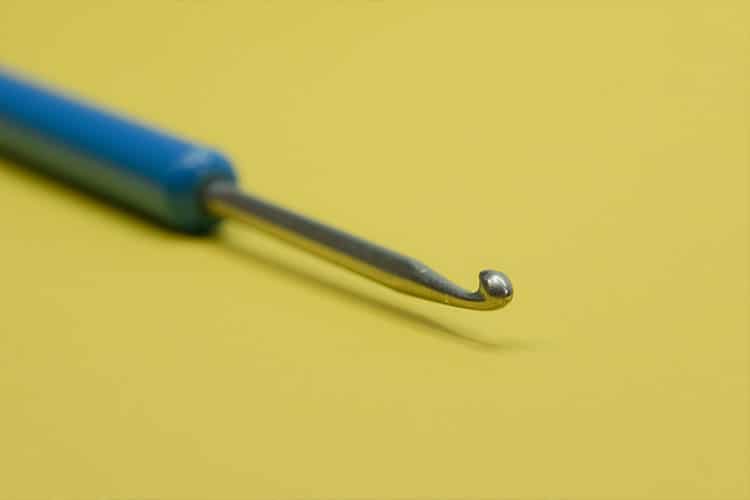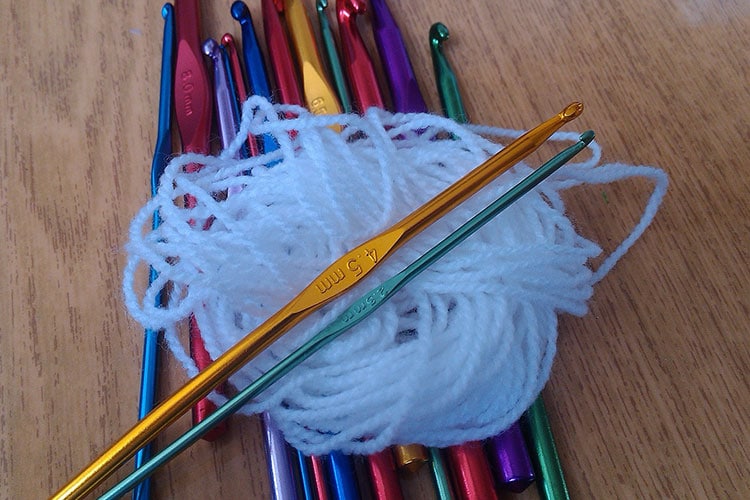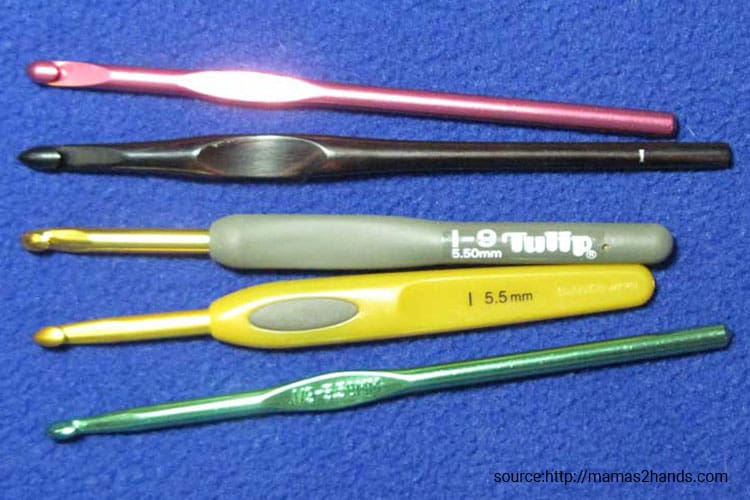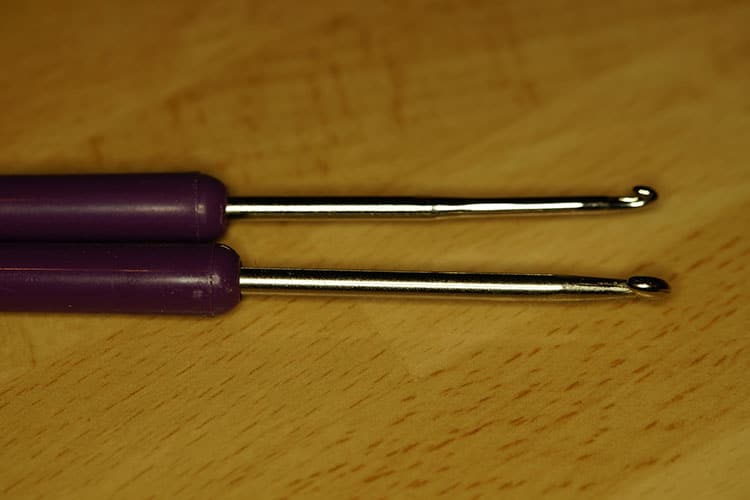Getting to know the sizes and types of crochet hooks available on the market can make a big difference as you learn to crochet. By learning the parts of a crochet hook and different sizes and materials can help you better understand the ways that projects and the process of crochet can change when you change hooks.
What are the common crochet hook sizes and types? Crochet hooks can vary by lots of different factors. The size of the hook, the material the hook is made out of, the shape of the hook and the handle design are some of the many ways hooks can differ. By changing the size and the type of different parts of the hook you can dramatically change the outcome of a project.
Before you learn about how the different hook sizes and types can change a project, it’s important to first learn about the different parts of a crochet hook.
Parts of a Crochet Hook

Crochet hooks may seem like a simple tool. Yet each part of a crochet hook has a name and a different purpose. Understanding the parts of a crochet hook and how they can differ from brand to brand can help you purchase the best crochet hook for your project and your skill level.
Handle – Beginning with the end of the crochet hook, you’ll find the handle. The handle of a crochet hook provides the right amount of balance and torque for you to pull the yarn through on the other end of the hook. Too short and you wouldn’t be able to pull with enough force. Too long and the handle would be in the way. Handles can come in several different designs (scroll down for more on this later) which changes the comfort of holding the crochet hook.
Grip/Thumb Rest – As you move towards the hook, the next part of the crochet hook is the grip or thumb rest. Crochet hooks with grips tend to be a bit more ergonomic whereas thumb rests are simply a wider, flattened area where the thumb can rest on the hook as you crochet. Often the thumb rest or grip is also where the size of the crochet hook is printed.
Shaft – Above the thumb rest or grip is the shaft (also known as a ‘shank’). This is the part of the hook that determines the size of the hook. The size of the shaft also determines the finished size of each crochet stitch. We’ll later review the different sizes of crochet hooks but in general the larger the shaft the larger the size of the hook.
Throat – Between the shaft and the head or hook is the ‘throat’ of the crochet hook. This is the part of the hook where the yarn rests as you are stitching and what catches the yarn each time you yarn over to pull through a stitch. Different crochet hooks have different length and shaped throats (more on this below). You’ll need to practice with a few different types before you decide which one works best for you.
Head – The final part of the crochet hook is the head or top where the hook is located. This is the part of the hook that is inserted into the previous row of stitches to form a new crochet stitch. Crochet hooks can have rounded or pointed heads. While most people select a rounded or pointed head based on personal preference, it can be helpful to use a more rounded head while working with a specialty yarn prone to separating.
The Different Types of Crochet Hooks

Once you understand the anatomy of a crochet hook, the next step is to learn the different ways that crochet hooks can vary. Not only can crochet hooks vary in size and the material they are made out of, but crochet hooks can also differ in the way that the head and handles are designed. Each of these variations can change the way your finish project looks and can also change the way in which you crochet. Let’s first look at the most common way crochet hooks differ, by the size of the shaft.
Hook Size
If you’ve spent any amount of time crocheting or reading crochet patterns, you already know that hook size can play a big role in the outcome of a finished project. As mentioned above, in general, the larger the crochet hook, the larger the stitch. The smaller the size of the crochet hook, the smaller the finished stitch will be. Getting the right sized hook for the yarn and project can make a big difference. Crochet hooks can be measured using several different measurement systems (US/American, Metric, UK/Canada) and each manufacturer has its own method of determining size.
Metric Crochet Hooks – Metric crochet hooks are sized by measuring the diameter of the shaft in millimeters. They are printed with sizes like 2.75 mm or 5 mm. The larger the size in millimeters, the larger the shaft of the crochet hook. Small metric crochet hooks start from the very small, 0.6 mm, up to the largest sizes of 15 mm or larger.
United States/American Crochet Hooks – In contrast, the US or American method of sizing crochet hooks deals in either letters, numbers or a combination of both. Lettered crochet hooks typically range in size from A-Q or by numbers 00-15. The larger the letter or number the larger the crochet hook size.
Just like converting centimeters to inches, converting metric crochet hook sizes to the American system of sizing is not straightforward. For example, an American sized J-10 hook is 6 mm and a K-10.5 hook is 6.5 mm. That’s a difference of 0.5 mm in size between the two hooks. This, however, is not the same difference in size as between a K-10.5 hook and an L-11 hook. L hooks are 8 mm which 1.5 mm difference between the two sizes. The increments between the American crochet hook sizes and the metric sizes are different, which makes converting the sizes very difficult.
UK/Canada – As if metric and US sizes were not complicated enough, the United Kingdom and Canada follow a numerical crochet hook measurement system like the United States system, but it’s backward. The smallest crochet hooks in the UK system are typically sized 14 or 13 whereas larger crochet hooks are sized 0, 00, or 000. It’s the exact opposite of the American system where the larger the number the larger the hook.
Knowing What Size Crochet Hook You Have Most high-quality crochet hook manufacturers will print the US and Metric hook sizes on the thumb rest or handle of the crochet hook. Occasionally though, you’ll find yourself in a situation where the sizing information was printed only on the package and not on the crochet hook itself. Or you may have decided to craft a homemade crochet hook and need to know the size of the final product.
In these situations, you can either measure the diameter of the crochet hook yourself (use a ruler to measure in millimeters and then convert to US or UK), or you can purchase a gauge tool. Gauge tools have 10-24 holes in different sizes cut into it. Each hole is numbered or lettered with the crochet hook sizing convention. To measure the hook you have, simply slide it into one of the holes on the gauge tool until it tightly fits. The size hole matches the size of your crochet hook.
Hook Material

Beyond size, the next biggest difference in crochet hooks is the type of material the hook is made out of. As manufacturing techniques have changed over time, so has the quality and type of crochet hook materials. There are a larger number of crochet hook materials available on the market now than ever before.
Wood – Wooden crochet hooks are popular among all crocheters. Versatile and comfortable to use, wooden crochet hooks are a good place to start as you learn to crochet. The type of wood used can vary by manufacturer, so it’s important to look for hooks of good quality and finish. Wood crochet hooks tend to be a bit more expensive than other materials, especially for higher quality woods. Also, note that wood hooks are often not suitable for tiny crochet hooks or thread/lace crochet. The wood becomes too thin and is at risk of breaking.
Bamboo – Bamboo hooks have become increasingly more popular in recent years, in part because they are an environmentally friendly resource. Similar to wood in their versatility and comfort, bamboo hooks are an attractive alternative to wood. Similar to wood hooks though, they may not be suitable for extra small hook sizes.
Plastic – Plastic crochet hooks are the most affordable material available on the market. Inexpensive and easy to care for, plastic hooks are a great choice for traveling and beginners. Plastic crochet hooks are also common for large/jumbo hook sizes where other materials would be too costly or too heavy for comfort. Unfortunately, plastic hooks are not the most comfortable to work with, as they can sometimes create friction between the hook and yarn.
Glass – Glass hooks are usually handcrafted, and highly customized. With infinite options for handles and custom colors and designs, glass crochet hooks are great for anyone who likes to crochet with flair. Yarn also tends to work smoothly on glass hooks allowing for less strain on your hands. That being said, they’re also fragile and at risk of breaking if dropped. Extra flair also means extra care!
Aluminum – Aluminum crochet hooks are the most common on the market and what many crocheters learn with. The hooks are affordable and a bit more user-friendly than plastic. Yarn slides well over aluminum hooks, they are long lasting and good for all types of projects.
Steel – Thread crochet and lace projects that require tiny crochet hooks are almost always called “steel hooks.” These hooks are stronger than wood or plastic when crafted into very small sizes for delicate projects. Steel crochet hooks have a different sizing conversion because rather than measure by diameter of the tiny hook, they are instead sized by the thread size to be used.
Combination — With growing popularity, it’s possible to find crochet hooks that are crafted with a combination of materials. Wooden hooks with plastic handles. Metal hooks with rubber handles. Plastic hooks with hard shafts and soft, rubbery handles. These are some of the many combinations available. Try out a few different hooks to achieve that perfect combination of comfort and workability.
Handcrafted — Finally, it’s possible to make a crochet hook from handcrafted materials. Try using household objects like chopsticks or a toothbrush to create a hook, or purchasing a crochet hook from an artist who specializes in the craft. If you’re not able to find the exact tool you’re looking for, a handcrafted hook might be the best choice.
Tapered vs. Inline Heads

Another way crochet hooks can differ is part of how the head and throat join together to form the top of the crochet hook. The heads can either be “tapered” or “inline” indicating the way that the head forms into the throat part of the hook. Tapered hooks have a head that is rounder and when you look at the hook lengthwise, it sticks out slightly farther than the rest of the shaft. In contrast, inline hooks are more pointed and the headlines up flush with the shaft or ‘inline’ with the rest of the hook.
Sometimes crochet patterns or books will refer to tapered vs. inline crochet hooks as the “Bates vs. Boye” debate. Two of the longest operating manufacturers of crochet hooks, Boye and Susan Bates produced different shaped heads. At the time there weren’t nearly as many choices in crochet hooks as there are now. Most crocheters picked either Boye hooks (tapered) or Bates hooks (inline) and stuck with that brand.
Ultimately, the type of head you choose is personal preference. Both kinds will produce exactly the same outcome for projects. Plus, there are so many choices in the marketplace now that there’s no need to stick in one camp or the other. Try out what you like best and go with whatever produces the best projects and is the most comfortable in your hands.
Handle Design
One final way crochet hooks can differ is shape is in the handle design. Traditional crochet hooks have a handle with a straight end and rounded edge. There’s nothing unique about the design, and they can sometimes cause hand and wrist stress in crocheters. With this in mind, several other handles have been developed for greater ergonomics or comfort.
Soft Touch – The handles on soft-touch crochet hooks are manufactured with metal or wooden hooks and large, cushy handles. The softer rubber or plastic materials of the handle can be helpful for crocheters with arthritis or who tend to hold with a tight grip on the hook.
“Swing” – Another ergonomically designed handle type is the ‘swing’ hook. A patented design, rather than a straight end the handle shape is bent into an “s” curve, which naturally fits the shape of your wrist and hand. The hooks also come in a wider handle size making them easier to grip for those with hand mobility issues.
Polymer Clay Handles – Some crocheters have taken to adding a DIY crochet handle to their existing hooks. Using polymer clay, these custom hooks can be shaped especially to your own hand size and shape, then baked in an oven at home right onto the metal hook. This gives a one-of-a-kind handle design that’s custom fit just to you.
Specialty Crochet Hooks

Nearby the shelves of standard crochet hooks in your local craft store, you may also find some specialty crochet hooks. These are great for trying out new techniques and for adding some variety to the tools in your crochet toolbox.
Tunisian Hooks – Tunisian crochet creates fabrics that look more like knitting than crochet and require a special Tunisian crochet hook. The hooks are longer than regular crochet hooks and do not have a thumb grip in order to easily allow multiple loops to slide on and off the hook like is done with knitting. Tunisian hooks can be purchased at most craft stores.
Double Ended or Circular – Another hook used in Tunisian crochet are double-ended crochet hooks or circular Tunisian crochet hooks. These look just like a regular crochet hook, except rather than a handle, the other end has a hook. Circular crochet hooks are connected together by a thin plastic cable. Double ended and circular crochet hooks are used for Tunisian crochet projects worked in the round or projects with lots of stitches held onto the row (like an extra large afghan).
Interchangeable Hooks – Crochet hook sets can now be purchased with one handle with interchangeable shaft sizes. This is especially helpful for specialty hooks like Tunisian or circular hooks where you only wish to purchase one handle but may need multiple hook sizes. It gives a range of possible projects but typically comes in a compact easy to manage carrying case.
Light Up – Some crocheters find it difficult to crochet or suffer from eye strain when working in low light settings or with dark yarns. Others wish to crochet once everyone has gone to sleep or when the cabin lights are off on an airplane. In recent years, lighted crochet hooks have come onto the market to help make it easier to crochet in low lighting conditions. The hooks are lit at the tip and work just like a standard crochet hook. They come in LED, battery operated, and rechargeable options.
Knooking Hooks – You may also come across crochet hooks that look like a combination of a hook and a knitting needle. Known as “knooking” the hook has a traditional crochet hook head, but the handle has a small hole in it. A cord or thread is laced through this hole and as you crochet, the stitches are ‘hung’ off the cord, just as the stitches hang off the previous row in knitting. Knooking hooks can also be used as regular crochet hooks without the cord.
Thread Hooks – As mentioned above, not all crochet hook materials are created equal when it comes to working on very small, delicate projects like lace or crochet thread. Special thread hook sets can be purchased that are designed to crochet with thread. These hooks will likely have a special labeling convention based on the thread weight, not the diameter of the hook.
Hooks for Alternative Materials – It’s important to know that if you decide to branch out into crocheting with other materials like wire, fabrics, or plastic bags you may wish to purchase a separate set of crochet hooks. Crocheting with these materials doesn’t necessarily require a different hook, but it can cause things like cracking and chipping. Choose metal hooks rather than softer materials like bamboo, and have a separate set of hooks for these materials than the set you use for yarns.
Trying New Crochet Hooks

Often times you’ll ask an experienced crocheter about why they use a particular brand, type or material for their crochet hooks and the response is “because that’s what I learned with.” Unfortunately, that may be a limiting belief that holds you back from enjoying all the other variations of crochet hooks on the market. While there’s no reason to purchase every crochet hook for your collection, it’s important not to be limited to only the crochet hooks you learned with or were given when you started.
Start with a crochet hook set that is affordable and well-rated. Look for one with a large variety of hook sizes to help you learn and practice gauge swatches. You’ll better understand how crochet hook size impacts the outcome of your finished work, and determine which sizes you’re most comfortable with.
Then borrow or purchase a few other crochet hooks. Start with trying hooks made out of different materials, then move into hooks with different handles or heads. If you belong to a crochet group, ask a friend what they like best and then try out those options.
When trying new hooks, monitor and ask yourself questions like: Do I crochet faster or slower with the new hook? Is my stitch tension more even or is it harder to get straight, uniform stitches? Does the hook feel too large, too small, or ‘just right’ for my hand size? When you finish a crochet sitting, be sure to monitor if you have more or less cramping or hand strain.
You might also find a better set of hooks that help you create better projects. After trying others you might also find you enjoy your current hooks the best. Either way, testing out a broad selection will ensure you have the best tools for your craft.
Related Questions

Is it okay to switch crochet hooks once you’ve started a project? Now that you know about all the differences in crochet hooks on the market, once you choose a crochet hook for a project you must use that same crochet hook for the entire project. Unless the pattern directs you to do so, switching crochet hooks (even if you use one marked the same size) will likely also change the size of your stitches. Depending on where it occurs in the project, it could impact the final outcome of your project.
Can you crochet without a hook? A common question we hear is whether it’s possible to crochet without a hook or crochet with a knitting needle instead. First, it is next to impossible to crochet with knitting needles because the hook is missing. It’s not that it cannot be done, but without the element of a hook, it’s difficult to create a crochet stitch with a knitting needle.
That being said, it’s possible to crochet with a crochet hook using finger crochet. It’s a technique to create regular crochet stitches using your finger as the hook. It is typically worked with soft, bulky yarns and patterns with simple crochet stitches. Finger crochet is also great for situations where crochet hooks are prohibited for safety reasons (international flights, psychiatric facilities, etc.)
What happens if you use the wrong size crochet hook? Using the wrong crochet hook size can make a big difference in the final look of your project. It’s important to make sure that you use the size recommended in the pattern or for the type of yarn you’re using.
Using a crochet hook that is larger than the size your pattern calls for will generally result in the finished item being larger or have looser stitches than the original. Larger crochet hooks create larger stitches meaning each row will be slightly longer and slightly taller than the pattern recommendation. If you select too large of a hook, you may not be able to complete the project at all.
Using a smaller crochet hook than the size recommended in your pattern will result in projects that are smaller than the pattern called for. This could mean your finished projects are too little to be functional or fit properly. Too small of a crochet hook may also slow down the speed of your crocheting.

